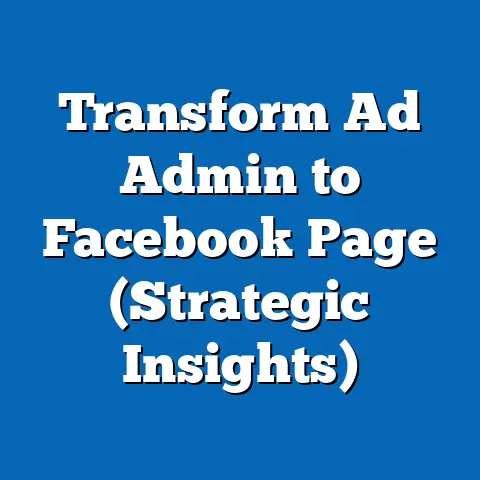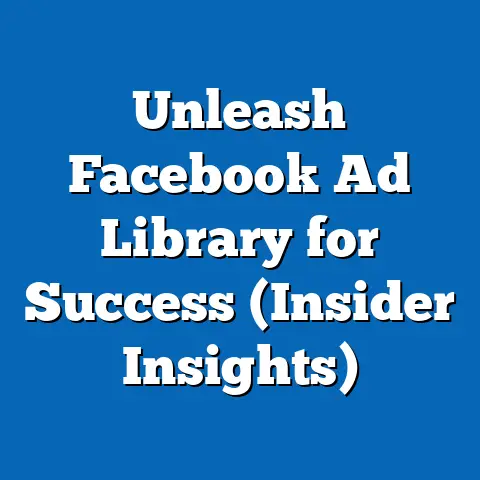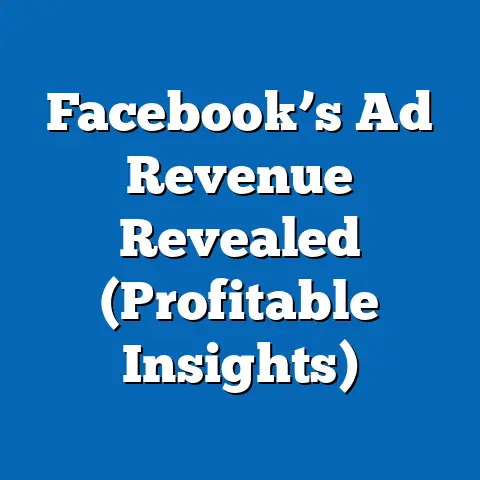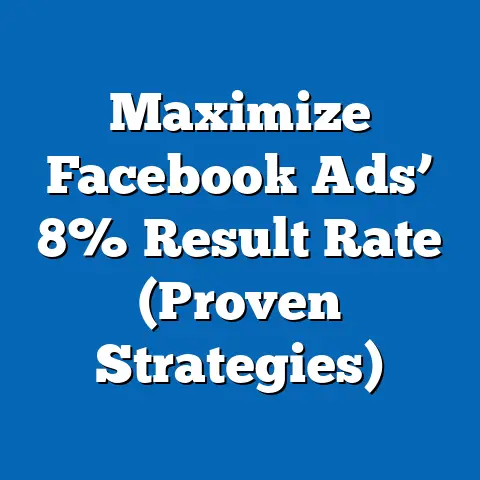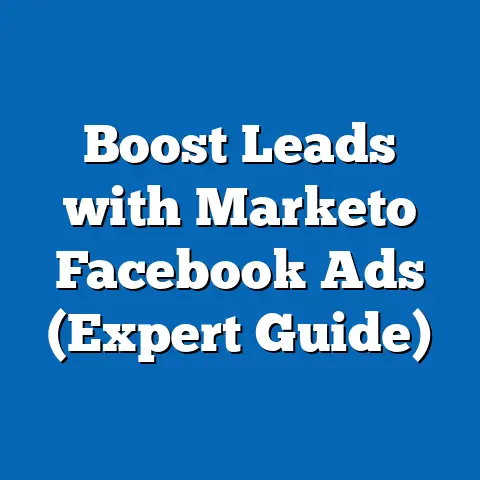Transform Video Ads for Facebook (Proven Strategies Inside)
In today’s hyper-connected world, businesses and marketers face a daunting challenge: how to stand out in a sea of content on platforms like Facebook, where users are bombarded with an estimated 4,000–10,000 ads daily. Video advertising, heralded as one of the most engaging formats, has become both a golden opportunity and a complex puzzle. With Facebook reporting over 2.9 billion monthly active users as of 2023, the platform offers unparalleled reach, yet the average user’s attention span has dwindled to mere seconds, making impactful video ads more critical—and more elusive—than ever.
This dilemma is compounded by the unique characteristics of video ads on Facebook: they must be visually compelling, emotionally resonant, and optimized for mobile-first, often silent viewing within the first three seconds. Unlike traditional advertising, where longer formats allowed for storytelling, Facebook video ads demand instant engagement in a scroll-heavy environment. The stakes are high—businesses that fail to adapt risk wasting budgets on content that gets ignored, while those who master the format can achieve viral reach and significant returns on investment (ROI).
Historically, advertising has evolved alongside technological and societal shifts, from print and radio in the early 20th century to television in the mid-1900s, and now to digital platforms like Facebook, which emerged as a social media giant in the early 2000s. The introduction of video ads on Facebook in 2014 marked a turning point, aligning with the rise of smartphone usage and the shift toward visual content consumption. Societally, this evolution reflects broader trends in how generations—particularly Millennials and Gen Z—consume media, prioritize authenticity, and engage with brands in an era of information overload.
The implications of mastering video ads on Facebook are profound, influencing not just marketing outcomes but also cultural perceptions of brands and consumer behavior. This article delves into proven strategies to transform video ads for Facebook, exploring the defining characteristics of effective content, historical context of digital advertising, and the societal and economic impacts of these trends. By blending data-driven insights with actionable tactics, we aim to equip marketers with the tools to navigate this complex landscape.
Section 1: Defining Characteristics of Effective Facebook Video Ads
The Need for Instant Impact
Effective Facebook video ads share a common trait: they capture attention immediately. According to a 2022 study by Facebook’s parent company, Meta, 65% of viewers decide whether to keep watching a video within the first three seconds. This necessitates bold visuals, striking text overlays, or intriguing hooks right at the start.
Unlike static ads, videos on Facebook often autoplay without sound, meaning they must communicate value visually before a user opts to unmute. Marketers must prioritize thumb-stopping imagery—vibrant colors, dynamic motion, or unexpected elements—that disrupts the monotony of a user’s feed. For instance, ads that open with a question or a surprising statistic tend to perform better in engagement metrics.
Mobile-First Optimization
With over 98% of Facebook users accessing the platform via mobile devices, video ads must be designed for smaller screens and vertical formats. Square (1:1) and vertical (9:16) aspect ratios outperform traditional horizontal formats, as they occupy more screen real estate and align with how users hold their phones. Meta’s research indicates that vertical videos see up to 35% higher completion rates compared to horizontal ones.
Additionally, mobile-first design means considering load times and data usage—videos should be lightweight without sacrificing quality. Text overlays and captions are also crucial, as 85% of videos on Facebook are watched without sound, per a 2021 Digiday report.
Emotional Resonance and Storytelling
While speed and visuals are critical, the most successful Facebook video ads also evoke emotion or tell a micro-story. Whether it’s humor, nostalgia, or inspiration, ads that connect on a human level tend to drive higher engagement and shareability. A 2020 study by Kantar found that emotionally engaging ads on social platforms like Facebook are 2.5 times more likely to result in a purchase intent.
However, storytelling must be concise—most effective ads are under 15 seconds, balancing narrative with brevity. Brands like Nike and Coca-Cola have mastered this, using short, impactful videos to convey messages of empowerment or connection without overwhelming viewers.
Section 2: Historical Context of Digital and Video Advertising
The Rise of Digital Advertising
The journey of advertising from print to digital mirrors broader technological advancements and societal shifts. In the late 1990s, the internet revolutionized marketing with banner ads, but it wasn’t until the launch of social media platforms like MySpace and Facebook in the early 2000s that targeted advertising became a game-changer. Facebook’s introduction of its advertising platform in 2007 allowed businesses to leverage user data for hyper-specific campaigns, a trend that intensified with the 2014 rollout of video ads.
This period coincided with the proliferation of smartphones, which transformed how content was consumed. By 2015, mobile ad spending surpassed desktop for the first time, according to eMarketer, signaling a seismic shift toward on-the-go, bite-sized content. Video, with its ability to convey complex messages quickly, emerged as a dominant format, fueled by faster internet speeds and platforms prioritizing visual media.
Generational Shifts and Media Consumption
The evolution of video advertising on Facebook also reflects generational differences in media consumption. Baby Boomers (born 1946–1964), who grew up with television, initially approached digital ads with skepticism, while Millennials (born 1981–1996) embraced social media as a primary source of information and entertainment. Gen Z (born 1997–2012), often dubbed “digital natives,” expects authenticity and interactivity, pushing brands to create ads that feel less like interruptions and more like native content.
Significant events, such as the 2008 financial crisis, shaped Millennials’ value-driven purchasing decisions, while Gen Z’s formative years during the rise of influencer culture and short-form content (e.g., Vine, TikTok) made them more receptive to snackable, creator-led video ads. Understanding these historical and generational contexts is crucial for tailoring video content on Facebook to diverse audiences.
Facebook’s Algorithm and Ad Evolution
Facebook’s algorithm has played a pivotal role in shaping video ad strategies. Early on, organic reach was high, but as the platform monetized through ads, businesses had to adapt to paid models and algorithm changes favoring engagement over reach. The 2018 pivot to “meaningful interactions” prioritized content sparking conversations, pushing marketers to create video ads that encourage comments and shares.
Section 3: Societal and Economic Implications of Facebook Video Ads
Cultural Shifts in Brand Perception
Video ads on Facebook have reshaped how society interacts with brands, blurring the lines between entertainment and advertising. Successful campaigns often feel like cultural moments—think of Dove’s “Real Beauty” videos, which sparked discussions on self-esteem, or viral challenges like the ALS Ice Bucket Challenge, which raised awareness through user-generated content. These examples illustrate how video ads can transcend selling to influence societal values and conversations.
However, this power comes with responsibility. Missteps, such as tone-deaf or overly commercialized ads, can lead to backlash, particularly among younger generations who value authenticity. The societal expectation for brands to align with social causes or transparency has grown, with 64% of consumers saying they’d buy from a brand that shares their values, per a 2022 Edelman Trust Barometer report.
Economic Impact on Businesses
Economically, video ads on Facebook have democratized marketing, allowing small businesses to compete with larger corporations through targeted, cost-effective campaigns. Meta reports that 71% of small businesses using its platforms saw increased sales due to video ads in 2021. The ability to test and iterate quickly—using tools like A/B testing and real-time analytics—has lowered barriers to entry, fostering entrepreneurship.
Yet, the flip side is increased competition and rising ad costs. As more businesses adopt video advertising, the cost-per-click (CPC) and cost-per-impression (CPM) on Facebook have risen by 17% and 20% respectively from 2021 to 2023, according to WordStream data. This trend underscores the need for strategic optimization to maximize ROI.
Workplace and Industry Evolution
The demand for effective video ads has also transformed the marketing industry, creating roles for video editors, social media strategists, and data analysts. Companies now prioritize in-house content creation or partnerships with influencers, reflecting a shift toward agile, authentic storytelling. Additionally, the gig economy has flourished, with freelancers offering specialized skills for short-term ad campaigns.
This evolution impacts workplace dynamics, requiring cross-generational collaboration. Older professionals may bring traditional marketing expertise, while younger team members offer insights into trends like meme culture or TikTok-inspired formats. Bridging these perspectives is essential for crafting resonant video content.
Section 4: Proven Strategies to Transform Facebook Video Ads
Strategy 1: Leverage the First Three Seconds
Given the fleeting attention spans on Facebook, the opening of a video ad must be magnetic. Start with a visually arresting image, a provocative question, or a quick demonstration of value. For example, a fitness brand might open with a before-and-after transformation shot, while a food company could show a mouthwatering dish being prepared.
Testing multiple openings using Facebook’s split-testing feature can reveal what resonates most with your audience. Data from HubSpot suggests that ads with clear calls-to-action (CTAs) in the first frame see 27% higher click-through rates (CTR).
Strategy 2: Optimize for Silent Viewing
Since most users watch videos without sound, incorporate captions or text overlays to convey key messages. Ensure text is legible on small screens—use large, bold fonts and high-contrast colors. Additionally, design visuals that stand alone; for instance, a product ad should show the item in use rather than relying on a voiceover.
Meta’s Creative Shop recommends keeping text to 20% or less of the frame to avoid clutter. This balance ensures the ad remains visually appealing while communicating effectively.
Strategy 3: Tailor Content to Audience Segments
Facebook’s robust targeting options allow marketers to create personalized video ads for different demographics, interests, and behaviors. A single campaign might include variations for Millennials seeking value-driven products and Gen Z craving trendy, creator-led content. Use dynamic creative tools to swap elements like text or imagery based on user data.
Qualitative feedback from focus groups can complement quantitative metrics like engagement rates. A 2021 Nielsen study found that personalized ads increase brand recall by 40%, highlighting the power of tailored storytelling.
Strategy 4: Incorporate User-Generated Content (UGC)
Authenticity reigns supreme on social platforms, and UGC—such as customer testimonials or challenge videos—builds trust. Encourage users to share their experiences with branded hashtags, then repurpose this content into ads. For example, GoPro frequently features user-submitted videos, blending community engagement with marketing.
UGC not only reduces production costs but also boosts credibility. A Stackla survey revealed that 79% of consumers find UGC more authentic than brand-created content, driving higher engagement.
Strategy 5: Focus on Short-Form Content with Strong CTAs
With attention spans shrinking, shorter videos (under 15 seconds) often outperform longer formats. Focus on a single message or benefit, and end with a clear CTA—whether it’s “Shop Now,” “Learn More,” or “Join Us.” Place CTAs both visually and in captions to accommodate silent viewers.
Analytics are key to refining this approach. Monitor metrics like video completion rate and CTR to identify optimal lengths and CTA placements for your audience.
Strategy 6: Experiment with Emerging Formats
Facebook’s evolving features, like Stories and Reels, offer fresh canvases for video ads. Stories, with their ephemeral nature, suit behind-the-scenes content or limited-time offers, while Reels capitalize on TikTok-style trends for viral potential. Both formats benefit from vertical video and interactive elements like polls or stickers.
Early adopters of new formats often see higher organic reach due to platform promotion. A 2022 Social Insider report noted that Reels ads achieved 22% more impressions than traditional feed ads during their initial rollout phase.
Section 5: Nuances and Diversity in Audience Responses
Generational Variations
While strategies like short-form content apply broadly, generational nuances shape how video ads are received. Baby Boomers may respond better to clear, informative ads with explicit value propositions, while Millennials appreciate storytelling tied to social impact. Gen Z, meanwhile, gravitates toward humor, memes, and influencer-driven content, often prioritizing entertainment over overt sales pitches.
Marketers must avoid stereotyping—within each generation, subcultures and individual preferences vary widely. A data-driven approach, using Facebook Insights to segment and test content, helps uncover these differences without relying on assumptions.
Cultural and Regional Differences
Global platforms like Facebook host diverse audiences, and video ads must account for cultural context. Humor that lands in one region may offend in another, while color symbolism or storytelling styles can differ significantly. For instance, collectivist cultures may resonate more with community-focused narratives, whereas individualistic ones prioritize personal achievement.
Localization—adapting language, imagery, and messaging—is essential. A 2020 CSA Research study found that 76% of consumers are more likely to purchase from brands offering content in their native language, underscoring the importance of cultural sensitivity.
Socioeconomic and Technological Factors
Access to technology and disposable income also influence ad reception. Users in developing regions may have slower internet, necessitating lightweight videos, while affluent audiences might expect high-production values. Similarly, economic conditions shape purchasing behavior—during recessions, ads emphasizing affordability perform better, as seen in post-2008 trends.
Acknowledging these disparities ensures campaigns are inclusive and effective across varied demographics. Testing and analytics can guide adjustments to meet diverse needs without overgeneralizing.
Section 6: Implications for Society, Culture, and the Workplace
Societal Influence of Video Ads
Facebook video ads are more than marketing tools; they’re cultural artifacts reflecting and shaping societal norms. Campaigns addressing mental health, diversity, or sustainability—such as Gillette’s “The Best Men Can Be” ad—can spark dialogue but also controversy if perceived as inauthentic. Brands must navigate this space thoughtfully, balancing advocacy with genuine commitment.
Moreover, the normalization of video content as a primary communication mode has altered how information spreads. Misinformation in ads can amplify societal divides, necessitating stricter platform regulations and ethical marketing practices.
Cultural Shifts in Content Consumption
The dominance of video on platforms like Facebook has accelerated a shift toward visual literacy, where images and short clips convey meaning faster than text. This trend, particularly pronounced among younger generations, influences education, entertainment, and even political discourse, as seen in meme-driven campaigns during elections. While this democratizes expression, it also raises concerns about depth and critical thinking in a soundbite-driven culture.
Brands play a role in this shift, using video ads to set trends or challenge norms. Their influence on cultural narratives underscores the need for responsibility in messaging.
Workplace Transformation
The rise of video advertising has reshaped marketing teams, demanding skills in video production, data analysis, and social media trends. Cross-generational collaboration is vital—Boomers and Gen X may offer strategic oversight, while Millennials and Gen Z bring digital fluency. Training programs and inclusive hiring practices can bridge gaps, fostering innovation.
Additionally, remote work, accelerated by the COVID-19 pandemic, has changed how ad content is created. Virtual brainstorming and cloud-based editing tools enable global teams to collaborate, reflecting a broader workplace trend toward flexibility and tech reliance.
Section 7: Forward-Looking Insights and Uncertainties
The Future of Video Ads on Facebook
Looking ahead, video ads on Facebook will likely evolve with advancements in artificial intelligence (AI) and augmented reality (AR). AI-driven personalization could create hyper-tailored ads in real time, while AR might enable immersive experiences, like virtually trying on products. Meta’s investment in the metaverse suggests a future where video ads integrate into virtual environments, though adoption rates remain uncertain.
Privacy concerns also loom large. With Apple’s iOS tracking changes and growing user demand for data control, Facebook’s ad targeting capabilities may face restrictions, pushing marketers to prioritize first-party data and creative storytelling over algorithmic precision.
Adapting to Generational Shifts
As Gen Alpha (born 2013–present) enters the consumer landscape, their expectations—shaped by immersive tech and short-form platforms—will further redefine video ads. Marketers must stay agile, experimenting with interactive formats and gamification to engage this cohort. However, balancing innovation with accessibility for older generations will remain a challenge.
The interplay between generational values and technological trends will shape ad strategies. Continuous research into emerging behaviors, coupled with ethical considerations, will be key to staying relevant.
Uncertainties and Ethical Considerations
The trajectory of video advertising on Facebook is not without risks. Regulatory scrutiny over data usage, content moderation, and misinformation could alter platform policies, impacting ad reach and effectiveness. Additionally, the mental health implications of constant ad exposure—especially on younger users—warrant attention, as studies link social media overload to anxiety and comparison stress.
Marketers must weigh commercial goals against societal impact, advocating for transparency and user well-being. The future of video ads on Facebook hinges on striking this balance amid evolving cultural and technological landscapes.
Conclusion
Transforming video ads for Facebook requires a deep understanding of the platform’s unique environment, historical advertising trends, and the societal forces shaping user behavior. By prioritizing instant impact, mobile optimization, emotional storytelling, and audience personalization, marketers can craft content that not only captures attention but also drives meaningful engagement. Proven strategies—such as leveraging UGC, focusing on short-form content, and experimenting with emerging formats—offer a roadmap for success in a competitive digital space.
Yet, the nuances of generational, cultural, and socioeconomic diversity remind us that there is no one-size-fits-all approach. As video ads continue to influence culture, economics, and workplaces, they carry both opportunity and responsibility. Looking forward, advancements in AI and AR, alongside evolving privacy norms, will redefine the landscape, challenging marketers to innovate while addressing ethical concerns.
Ultimately, the journey to transform video ads on Facebook is an ongoing process of adaptation and learning. By grounding strategies in data, empathy, and foresight, businesses can navigate uncertainties and harness the platform’s potential to connect with audiences in impactful, authentic ways.

